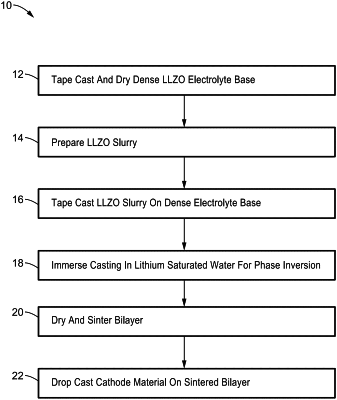| CPC H01M 4/131 (2013.01) [H01M 4/664 (2013.01); H01M 4/801 (2013.01); H01M 10/058 (2013.01)] | 4 Claims |

|
1. A method of forming a porous tape structure, the method comprising:
(a) forming a slurry of LLZO powder, a binder and a solvent;
(b) tape casting the slurry on a substrate to form a LLZO tape;
(c) applying a sacrificial layer on the LLZO tape to produce a bi-layered LLZO tape;
(d) immersing the bi-layered LLZO tape in water to induce solvent/water exchange;
(e) removing the bi-layered LLZO tape from the water and drying the bi-layered LLZO tape; and
(f) heating the bi-layered LLZO tape to remove the sacrificial layer and sinter the LLZO tape to produce a sintered LLZO tape;
(g) wherein a sintered LLZO tape with elongate pores with a length aligned perpendicularly to a top surface of the sintered LLZO tape is produced;
(h) wherein the water for solvent/water exchange further comprises a lithium salt selected from the group consisting of Li2CO3, LiCl, LiOH, LiNO3 and Li2SO4; and
(i) wherein lithium loss from solid materials during solvent exchange is inhibited.
|